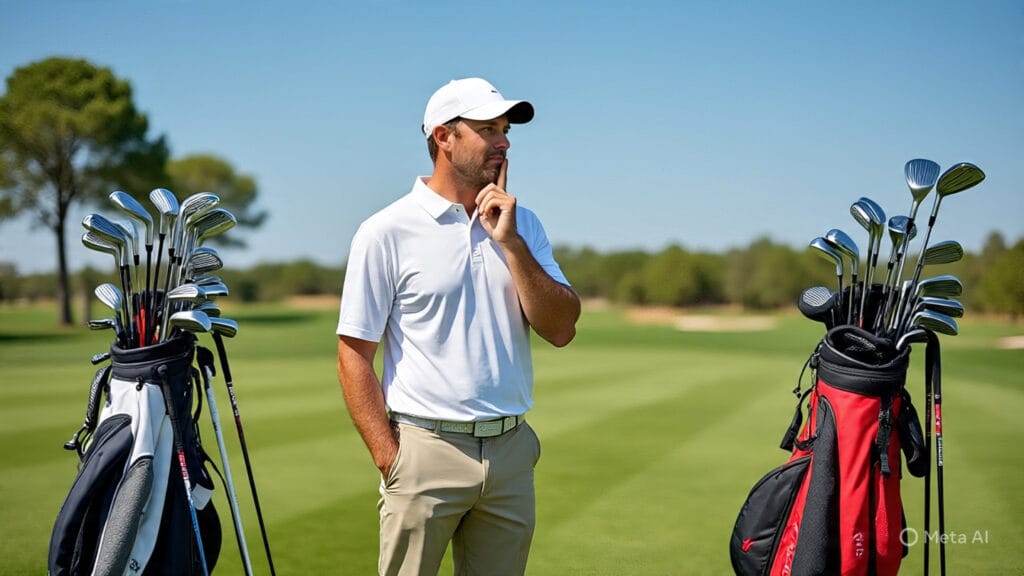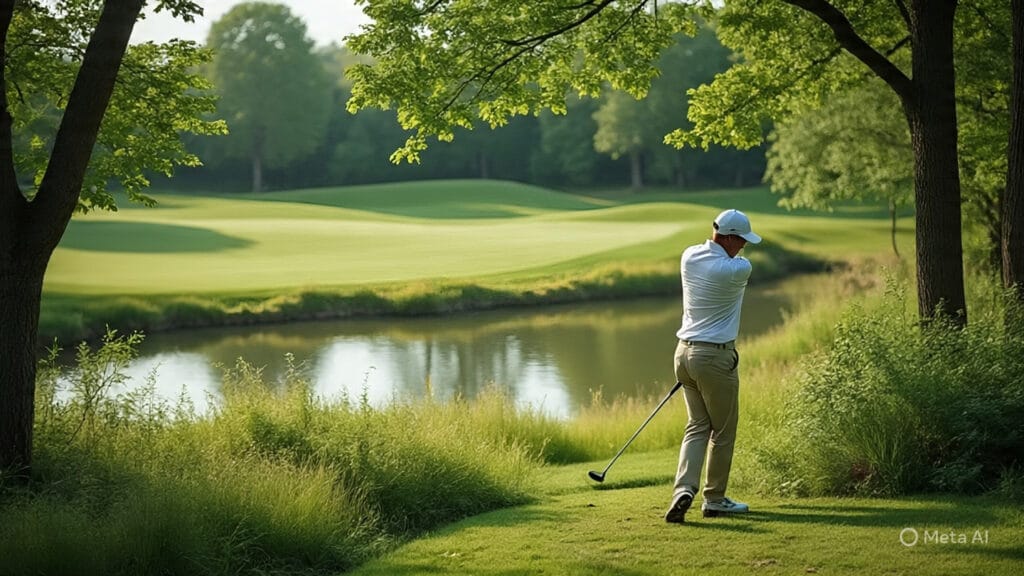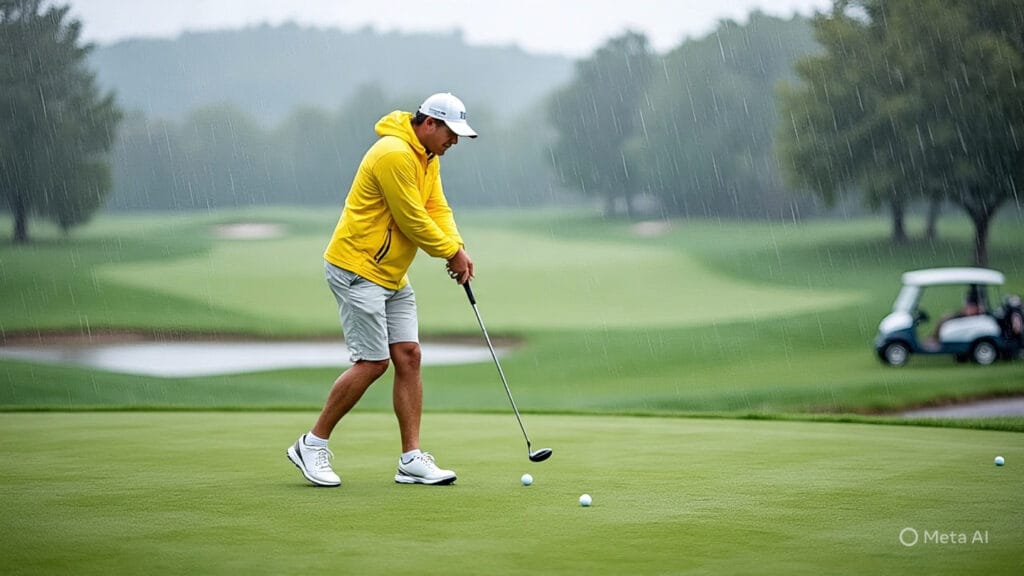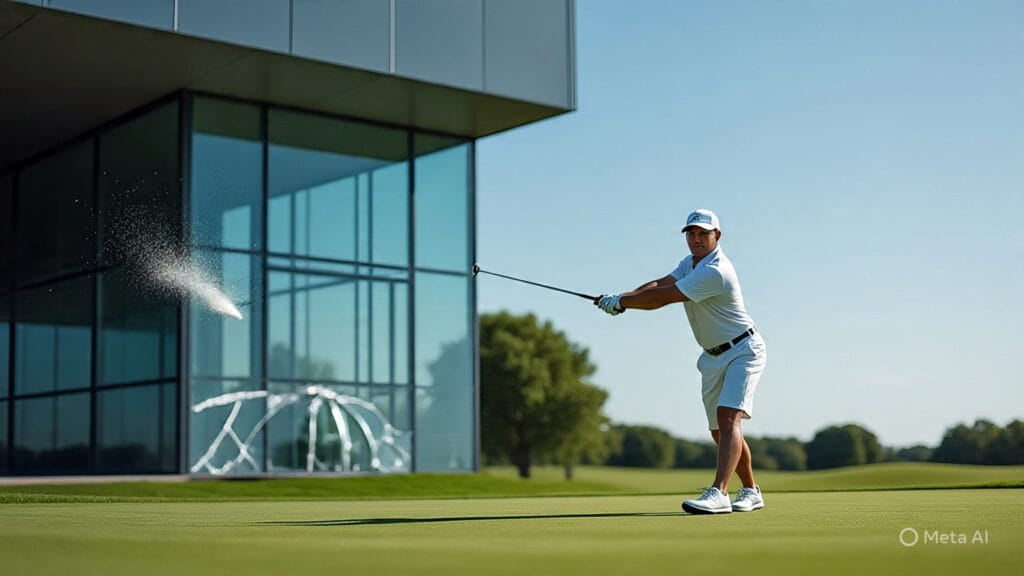Top Takeaways and Key Concepts
Please Note: This post may contain affiliate links. If you click one of them, we may receive a commission at no extra cost to you. As an Amazon Associate, I earn from qualifying purchases.
→ Identify common hazards like bunkers, water, and trees before each hole to plan safer shots.
→ Study the course layout carefully to anticipate challenges and avoid risky zones.
→ Choose clubs wisely based on distance, elevation, and hazard placement for smarter play.
→ Develop calm recovery strategies to handle tough situations efficiently and confidently.
→ Embrace mistakes as learning tools to strengthen resilience and improve future performance.
Summary of This Article
This article helps golfers face course hazards with strategy and confidence. It teaches players how to assess layouts, pick smart clubs, and recover calmly from mistakes. By turning bunkers, water, and trees into learning opportunities, golfers can sharpen their game, stay composed, and enjoy every round with greater control and positivity.
Video Summary
The golf course! Out there, it's so beautiful. There is green grass all over the place, lovely bunkers that are ready to catch your ball, and those sneaky water hazards that show up when you least expect them. Do you know what I mean? One minute you feel like a star, and the next your ball is going down like it's in a pool.
It can be annoying. Really. But we can work this out together! You don't have to want to pull your hair out or toss your clubs when you get to those hard parts. Let's talk about some simple strategies to deal with it without becoming upset or losing our balls!
Take a second when you spot a bunker or water hazard ahead. Take a deep breath. Instead of worrying about what could go wrong, think about where you want the ball to go. Imagine it flying straight down the fairway or falling softly on the green. That tiny technique for your mind works!
It also matters the club you choose. If you're near to the water and feel good about hitting that shot, you might want to use a club that provides you more height. If something goes wrong, you'll have more room between your ball and that sly water.
And don't forget to practice! The more time you spend on the course, the better you'll grow at finding those trouble places before they catch you off guard. You'll find out which clubs are best for different scenarios.
Keep in mind that everyone has times when things don't go as planned. Don't worry about it; just keep going! Having fun and spending time outside with friends (or even just by yourself) is what golf is all about. So let's work on those problem areas together and keep happy as we do it!
Understanding Common Hazards

First things first, let’s chat about those usual suspects on the golf course. You know the ones. Bunkers, water, and trees. They’re like the three amigos of trouble waiting to mess with your game.
Bunkers can be quite tricky at times. They look all soft and sandy, but trust me, they can be a pain! Kind of like that friend who always wants to hang out but ends up making things harder for you. You think you're just going to have fun, then bam—you’re stuck trying to get out of there!
Water hazards? Oh boy. Those sneaky spots look so nice and shiny until your ball decides it wants to go swimming instead of playing golf. It’s like your ball says, “See ya later!” and takes a permanent vacation in the drink. So frustrating!
Then there are the trees. Just standing there all tall and proud, reminding us how off our aim can be sometimes. I remember my buddy Jim once aimed straight for the fairway. He thought he had it made! Then—wham! His drive hit a tree and bounced right into a pond. I couldn’t help but laugh so hard I almost forgot about my own slice heading straight toward the sand trap.
It happens to all of us! But hey, we learn from these moments too. Every time you face one of these hazards, take a deep breath and think about what you can do next time. Maybe choose a different club or aim a little differently.
Golf is all about having fun—even when those hazards try to ruin your day! Keep smiling through it all, because every round is another chance to improve and enjoy being outside with friends (or just enjoying some peace). Let’s keep swinging away together!
Reading the Golf Course

The next step is to read the course. Doesn't it sound easy? But believe me, it's very crucial! Before you even think about taking your first tee shot, have a look around.
Look at where everything is. Are there indications that tell you to be careful around water? You know those deceptive places that look nice but can spoil your day? And what about those scary bunkers? They like to lurk near the green and wait for a ball to come by.
A lot of golfers get so into their game plan that they forget this stage. I have done it too! Don't look around beforehand; just rush in. Then, boom! You didn't want your ball to go there, but it did.
It helps a lot to take the time to learn how each hole is set up. It's like having a hidden map of the course! You can avoid such hazards and save yourself strokes and maybe even some embarrassment if you know where they are.
Picture yourself at the tee box, where you can see everything perfectly. Knowing what's coming will make you feel more sure of yourself. You can even impress your pals with how much you know about the course!
So, the next time you're out there, stop for a second before you swing. Take a look around and take it all in. It's not only about hitting the ball; you also have to be clever and have fun while you do it!
Choosing Your Golf Club Wisely

Let's see—picking the right club is quite vital when you're up against those tough risks! I understand. Every time, it feels so tempting to grab your driver. When you swing that large club, you feel strong, like Thor with his hammer. But sometimes, you really need to be careful.
Picture this: you're on a par three hole, and there's water right past the green. You might be feeling ambitious and ready to let that driver go. But hold on! Instead of shrieking “fore!” and sending your ball into the drink, why instead grab an iron or hybrid?
That tiny switch could rescue you from a disaster in the water! Using a smaller club keeps things secure while yet letting you go close enough to make a putt. You will feel better when your ball lands on the green instead of plunging into the sea.
It's more important to consider than to just swing hard. Choosing the right club can make a major difference in your game and spare you from frowning when you lose another ball. Also, it feels wonderful to play smart and not only rely on strength.
So, the next time you're out there, take a second to think about which club will assist you get around those problems the best. You might be surprised by how well it works out!
Planning Your Golf Shot

Now comes the fun part: planning your shot! Imagine this: you're about to hit your ball and face the tough obstacles around you. It's like getting ready for a small fight. What do you want to do? Should you travel left to stay safe or right to avoid danger? This choice could change everything. You could be sinking a birdie one minute and then be face-first in another hazard the next!
When I run into problems on the course, I like to think of myself as an explorer mapping new territory. It makes things more fun instead of frustrating. I'm not simply another golfer who doesn't want to make a fool of myself. That way of thinking helps me stay focused and hit the ball correctly.
What a feeling that would be! You're figuring out how to get around the course, exactly like an explorer would in a jungle. You have your map (or scorecard) in hand, and each hole is a fresh task for you to face.
Take a big breath before you line up that shot. Take a look at what's ahead. Think about where you want your ball to go and what things are in the way. Seeing it in your mind can make a big impact.
Planning also makes you feel more sure. If you think about each swing before you do it, you'll feel more sure about it. And who knows? You might be surprised at how well it goes! Enjoy being out there and exploring; it's all part of the fun!
The Art of Recovery Shots

But what if something bad happens anyway? Don't worry! The skill of recovery shots is designed to help us not feel completely lost when we miss our targets. I know how you feel; I've been there too. Don't panic if you're stuck in a bunker or hidden behind some trees. Just take a big breath and relax.
Don't panic; instead, think about how to get back on track. It's like putting together a small puzzle. You want to find the greatest strategy to attain your goal without making things worse. It's better to be safe than sorry and not strive to be a hero and get into more problems later.
Think about being in the bunker. It may look hard, but you can still make a nice shot! You may try using a sand wedge instead of your driver. That will help you get the ball right onto the green without hitting anything else.
Look for gaps if you're behind those trees. There might be a clever way to get through! Instead of aiming for a massive swing that could get you into greater trouble, a modest chip shot could get you back in the game.
The key is to keep cool and think rationally. Keep in mind that every golfer hits terrible shots from time to time. Even the best! What important is how we get back on our feet after them. So the next time things go wrong, stay calm and think about how to make the greatest choice for your next shot. You can do it!
Practicing Your Short Game

We now know that staying away from trouble locations takes some clever thought. But we should also remember to work on our short game talents. When you're close to the greens and there are impediments all around, practicing your chipping can definitely help.
When you chip, it's like dancing with your ball. You need to be careful and sensitive. When you have to hit those tiny chips around bunkers, it's very satisfying. I mean, who doesn't like that? It feels great to hit a chip shot, even if your previous tries didn't go as planned.
Picture yourself standing next to the green with a hard bunker just waiting for you to make a mistake. Your heart might beat a little faster, right? But if you've worked on those chips, it will be easy. Knowing how to get the ball near to the hole will make you feel more sure of yourself.
You might think of each practice session as adding new tools to your toolbox. The more you chip, the better you'll be able to deal with adverse scenarios in a game. And hey, everyone has bad days out there! What counts is how we learn from our mistakes and get better.
So the next time you go out to practice, pay attention to those chips. Imagine how easy it would be to glide the ball over things. Stay cool and know that all of your hard work will pay off when it matters!
Learning From Golfing Mistakes

Let's talk about how we can deal with the little mistakes we all make while we play golf. Doesn't it happen to everyone? Sometimes even the best players miss shots. No one is perfect, except for Jack Nicklaus. That guy was something else!
It could be annoying when you mess up. But you know what? You can learn from every mistake and get better. That's how you get better over time. Every time you pick up your club after a terrible shot, you're becoming better. It's like giving your self-esteem a boost.
When you're out there dealing with challenges from bunkers or trees, don't forget to breathe deeply. Take your time. And don't forget to laugh at the funny portions! Sometimes I giggle when my ball flies off course and into the bushes. That's how the game goes.
What matters most is that you have fun at the event. Whether you make that putt or send your ball flying into the ocean, have fun. You should be having fun while playing golf, so remain smiling and focus on that. Every round is a new adventure just waiting for you!
Featured Snippet: To handle golf course hazards effectively, study the layout, choose clubs strategically, and stay calm after mistakes. Understanding bunkers, water, and trees helps you plan smarter shots, recover efficiently, and turn every challenge into a chance to improve your confidence and consistency on the course.
Frequently Asked Questions
What are the most common hazards on a golf course?
The most common hazards are bunkers, water obstacles, and trees. Learning to recognize and plan around them helps prevent unnecessary strokes.
How can I avoid water hazards in golf?
Aim for safer zones, use higher-lofted clubs, and practice distance control to reduce the risk of hitting into water hazards.
What should I do if my ball lands in a bunker?
Use a sand wedge, open your clubface, and swing through the sand to lift the ball cleanly onto the green.
How can I recover from a bad shot during a round?
Stay calm, assess your position, and choose a safe recovery shot instead of taking risky plays that could worsen your score.
Why is reading the course layout important?
Reading the layout helps you identify hazards, plan your shots strategically, and make confident club selections throughout the game.
What is the best way to choose the right golf club?
Select your club based on distance, elevation, and surrounding obstacles. Avoid automatically reaching for the driver on every tee shot.
How can I improve my mental game after making mistakes?
Take a deep breath, refocus on the next shot, and view each error as a learning opportunity to strengthen your confidence and mindset.
Suggested Resources
Golf Digest Guide to Hazards
https://www.golfdigest.com/story/golf-hazards-guide
Mastering Golf Course Management
https://www.golf.com/instruction/2020/05/06/mastering-golf-course-management/
Tips for Playing Out of Bunkers
https://www.pga.com/news/golf-bunker-play-tips

Kevin Collier is an avid golfer and contributing author at AIGolfTips.com, where he shares his passion for the game through expert tips, techniques, and gear reviews. With years of experience on the course, Kevin offers valuable insights for golfers of all skill levels, helping them improve their game and maximize their potential. Whether discussing swing mechanics or the latest in golf technology, Kevin's engaging approach aims to inspire and educate fellow golf enthusiasts to elevate their performance and enjoy every moment on the green.




